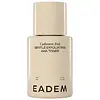What's inside
What's inside
 Key Ingredients
Key Ingredients

 Benefits
Benefits

 Concerns
Concerns

 Ingredients Side-by-side
Ingredients Side-by-side

Water
Skin ConditioningPropanediol
SolventGluconolactone
Skin ConditioningCaprylic/Capric Triglyceride
MaskingLactic Acid
BufferingTranexamic Acid
AstringentSodium Hydroxide
BufferingPrunus Amygdalus Dulcis Oil
Skin ConditioningBetaine
HumectantColloidal Oatmeal
AbsorbentOryza Sativa Bran Water
MaskingTocopherol
AntioxidantSphingomonas Ferment Extract
Skin ConditioningPanthenol
Skin ConditioningLeuconostoc/Radish Root Ferment Filtrate
AntimicrobialAzelaic Acid
BufferingHydrogenated Lecithin
EmulsifyingSodium Citrate
BufferingEthylhexylglycerin
Skin ConditioningPolyglyceryl-10 Stearate
Skin ConditioningCitric Acid
BufferingTrisodium Ethylenediamine Disuccinate
Phenoxyethanol
PreservativeWater, Propanediol, Gluconolactone, Caprylic/Capric Triglyceride, Lactic Acid, Tranexamic Acid, Sodium Hydroxide, Prunus Amygdalus Dulcis Oil, Betaine, Colloidal Oatmeal, Oryza Sativa Bran Water, Tocopherol, Sphingomonas Ferment Extract, Panthenol, Leuconostoc/Radish Root Ferment Filtrate, Azelaic Acid, Hydrogenated Lecithin, Sodium Citrate, Ethylhexylglycerin, Polyglyceryl-10 Stearate, Citric Acid, Trisodium Ethylenediamine Disuccinate, Phenoxyethanol
Water
Skin ConditioningGlycolic Acid
BufferingSodium Hydroxide
BufferingGlycerin
HumectantPropanediol
SolventEthylhexyl Olivate
Skin ConditioningHydroxyethyl Acrylate/Sodium Acryloyldimethyl Taurate Copolymer
Emulsion StabilisingC13-14 Isoparaffin
EmollientC11-12 Isoparaffin
Skin ConditioningPhytic Acid
Malic Acid
BufferingMandelic Acid
AntimicrobialLactic Acid
BufferingLipase
Skin ConditioningProtease
ExfoliatingSqualane
EmollientPolyglyceryl-10 Stearate
Skin ConditioningC15-23 Alkane
SolventHydroxyacetophenone
AntioxidantPhenoxyethanol
PreservativeTricaprylin
MaskingGlyceryl Oleate
EmollientEthylhexyl Polyhydroxystearate
EmollientTetradecane
PerfumingC13-14 Alkane
SolventDecyl Glucoside
CleansingMaltodextrin
AbsorbentXanthan Gum
EmulsifyingLecithin
EmollientSclerotium Gum
Emulsion StabilisingPolyglyceryl-4 Oleate
EmulsifyingCarrageenan
Silica
AbrasiveWater, Glycolic Acid, Sodium Hydroxide, Glycerin, Propanediol, Ethylhexyl Olivate, Hydroxyethyl Acrylate/Sodium Acryloyldimethyl Taurate Copolymer, C13-14 Isoparaffin, C11-12 Isoparaffin, Phytic Acid, Malic Acid, Mandelic Acid, Lactic Acid, Lipase, Protease, Squalane, Polyglyceryl-10 Stearate, C15-23 Alkane, Hydroxyacetophenone, Phenoxyethanol, Tricaprylin, Glyceryl Oleate, Ethylhexyl Polyhydroxystearate, Tetradecane, C13-14 Alkane, Decyl Glucoside, Maltodextrin, Xanthan Gum, Lecithin, Sclerotium Gum, Polyglyceryl-4 Oleate, Carrageenan, Silica
 Reviews
Reviews

Ingredients Explained
These ingredients are found in both products.
Ingredients higher up in an ingredient list are typically present in a larger amount.
Lactic Acid is another well-loved alpha hydroxy acid (AHA). It is gentler than glycolic acid but still highly effective.
Its main role is to exfoliate the surface of the skin by loosening the “glue” that holds dead skin cells together. Shedding those old cells leads to smoother, softer, and more even-toned skin.
Because lactic acid molecules are larger than glycolic acid, they don’t penetrate as deeply. This means they’re less likely to sting or irritate, making it a great choice for beginners or those with sensitive skin.
Like glycolic acid, it can:
Lactic acid also acts as a humectant (like hyaluronic acid). It can draw water into the skin to improve hydration and also plays a role in the skin's natural moisturizing factor (NMF) in the form of sodium lactate.
Studies show it can boost ceramide production to strengthen the skin barrier and even help balance the skin’s microbiome.
To get results, choose products with a pH between 3-4.
Lower strengths (5-12%) focus on surface exfoliation; higher strengths (12% and up) can reach deeper in the dermis (deeper, supportive layer) to improve skin texture and firmness over time.
Though it was originally derived from milk, most modern lactic acid used in skincare is vegan. It is made through non-dairy fermentation to create a bio-identical and stable form suitable for all formulations.
When lactic acid shows up near the end of an ingredient list, it usually means the brand added just a tiny amount to adjust the product’s pH.
Legend has it that Cleopatra used to bathe in sour milk to help reduce wrinkles.
Lactic acid is truly a gentle multitasker: it exfoliates, hydrates, strengthens, and brightens. It's a great ingredient for giving your skin a smooth, glowing, and healthy look without the harshness of stronger acids.
Read more about some other popular AHA's here:
Learn more about Lactic AcidPhenoxyethanol is a preservative that has germicide, antimicrobial, and aromatic properties. Studies show that phenoxyethanol can prevent microbial growth. By itself, it has a scent that is similar to that of a rose.
It's often used in formulations along with Caprylyl Glycol to preserve the shelf life of products.
Polyglyceryl-10 Stearate is a skin conditioner with emollient and emulsifier properties.
It is an esther of stearic acid and Polyglycerin-10.
This ingredient may not be Malassezia folliculitis, or fungal-acne safe.
Learn more about Polyglyceryl-10 StearatePropanediol is an all-star ingredient. It softens, hydrates, and smooths the skin.
It’s often used to:
Propanediol is not likely to cause sensitivity and considered safe to use. It is derived from corn or petroleum with a clear color and no scent.
Learn more about PropanediolSodium Hydroxide is also known as lye or caustic soda. It is used to adjust the pH of products; many ingredients require a specific pH to be effective.
In small amounts, sodium hydroxide is considered safe to use. However, large amounts may cause chemical burns due to its high alkaline.
Your skin has a natural pH and acid mantle. This acid mantle helps prevent harmful bacteria from breaking through. The acid mantle also helps keep your skin hydrated.
"Alkaline" refers to a high pH level. A low pH level would be considered acidic.
Learn more about Sodium HydroxideWater. It's the most common cosmetic ingredient of all. You'll usually see it at the top of ingredient lists, meaning that it makes up the largest part of the product.
So why is it so popular? Water most often acts as a solvent - this means that it helps dissolve other ingredients into the formulation.
You'll also recognize water as that liquid we all need to stay alive. If you see this, drink a glass of water. Stay hydrated!
Learn more about Water